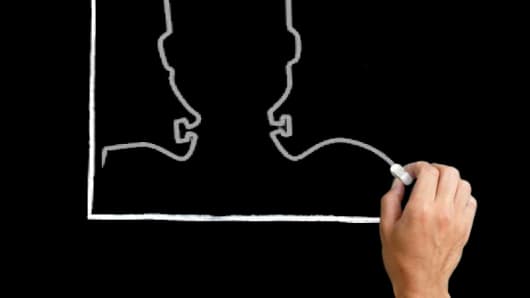The recent selloff in stocks has triggered a scary "head and shoulders" pattern in the S&P 500 chart, signaling that there may be more selling to come.
The so-called head and shoulders pattern is formed when the chart pattern shows three rallies, with the middle rally peaking higher than the first and second, thus creating a head. If the market breaks the "neckline," that is a trend reversal signal and can mean more selling ahead.
"What we're having is a classical technical breakdown. When the S&P broke down through the 1248 to 1250 region, it violated the neckline on a head and shoulders formation, " said Art Cashin, director of floor trading at UBS .
"If it's a valid head and shoulders then you begin a countdown to where it occurred. I think it counts down to 1120," Cashin said.
"You watch the rebounds. They should be restrained by the neckline at 1248 to 1252. A rally can only be a success if it punches above that," he said.
The pattern doesn't always trigger a break through the neckline and a selloff.
"There have been a few head fakes with this pattern since we came off the 2008 lows," said Scott Redler of T3Live.com. He said the S&P started forming the pattern several times, but it was never triggered. "That's why nobody trusts this pattern, but it feels different this time."
In the chart below, the market first rallied, forming the top of the left shoulder in late February. It then rallied to a higher level, forming a head in May. It then dipped down to a neckline before rallying to form a right shoulder in July. Typically, the neckline is formed at an area of prior support. That would be the 1249 to 1280 zone, according to Redler.
"(Wednesday's) move down through 1249 was the bottom end of the neckline which traders have been watching," said Redler. "What a head and shoulders tries to do is it tries to measure the potential move of a correction and the way you do that is from the top of the head to the neckline. The high was 1370. The neckline would be an average of 1270. That gives you a measured move for technicians to pick an area to buy. That takes you down to a zone of 1150 to 1180," he said.
"That correlates to a pretty big support level from last year. That will be the level traders are watching," he said.
Sometimes market's bounce back up after breaking the neck line, in a "kiss back" move, and that's what happened Wednesday when stocks recovered most of their losses to close slightly lower.
Redler said another reason he was expecting this formation to be triggered was by the action in the industrial sector ETF, Industrial Select Sector SPDR Fund and the SPDR S&P Homebuilders ETF. Both showed head and shoulder patterns before the S&P.
Redler, who watches the market's short-term technicals, recommended raising macro cash in longer-term positions last Thursday when he saw the right shoulder start to get fully developed. It was also apparent when the SPY, the ETF representing the S&P, broke its 50-day moving average at 1310.
Questions? Comments? Email us at marketinsider@cnbc.com



